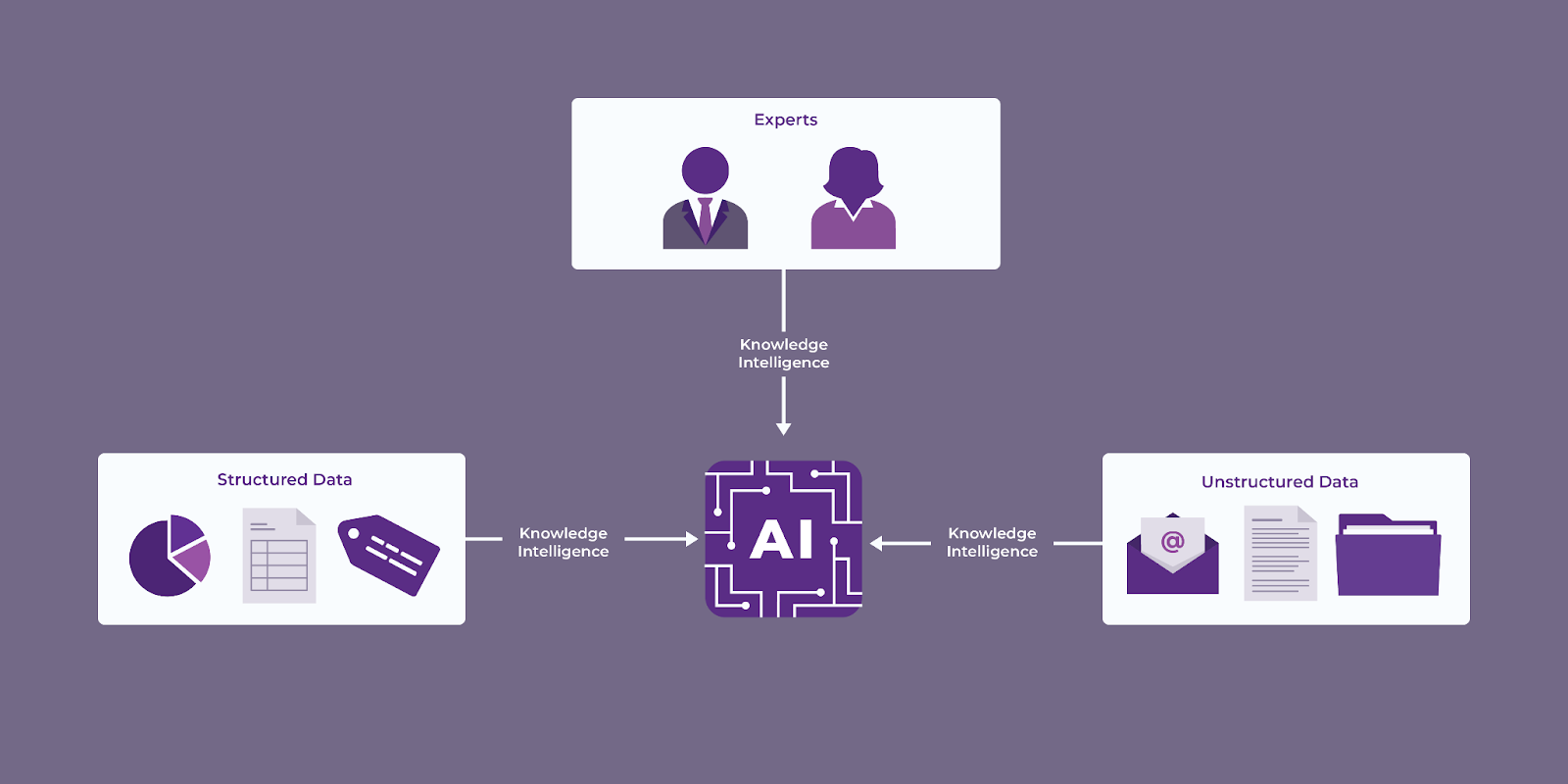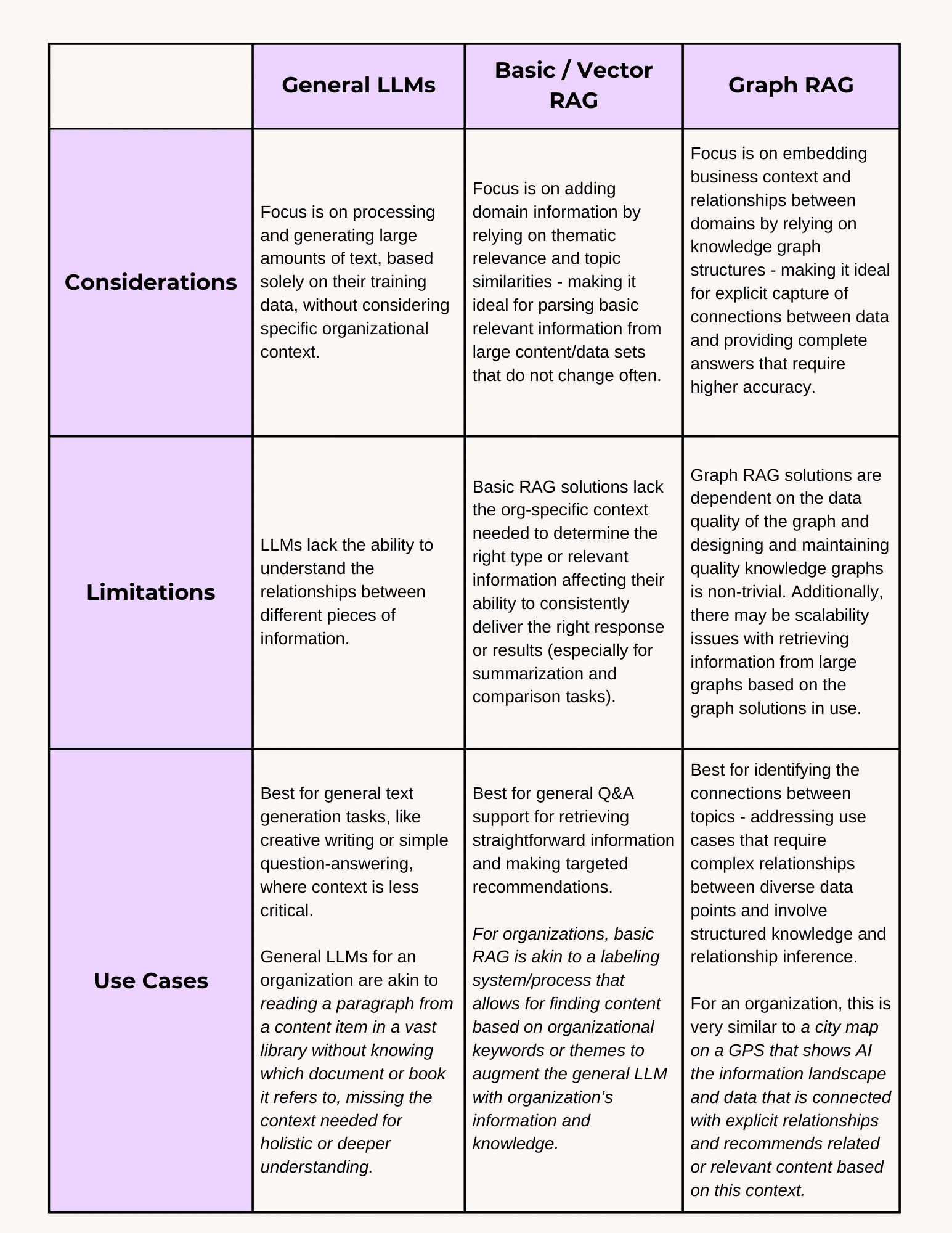Generative AI (GenAI) has made Artificial Intelligence (AI) more accessible to the business, specifically by empowering organizations to leverage large language models (LLMs) for a wide range of applications. From enhancing customer support to automating content creation and operational processes, the investment in AI has surged in the past two years – primarily through proofs of concept (POCs) and pilot projects.
For many organizations, however, these efforts have failed to yield the anticipated results proportional to their investments. According to Gartner’s recently published “Hype Cycle for Artificial Intelligence, 2024”, AI has entered the “trough of disillusionment.”
We’re witnessing this firsthand as organizations are hiring EK to address AI projects that have stalled due to content and data challenges. Many are still grappling with how to ensure quality and diversity of their AI products – with the biggest hurdle being the lack of institutional and domain knowledge that AI requires to deliver meaningful results tailored to a specific organization.

The reality is that algorithms trained in one company or public data sets may not work well on organization and domain-specific problems, especially in domains where industry preferences are relevant. Thus, organizational knowledge is a prerequisite for success, not just for generative AI, but for all applications of enterprise AI and data science solutions. This is where experience and best practices in knowledge and data management are lending the AI space effective and proven approaches to how domain and institutional knowledge can be shared effectively. Below, I have picked the top three ways we have been working to embed domain and organizational knowledge and empower enterprise AI solutions.
1. Semantic Layer
Without context, raw data or text is often messy, outdated, redundant, and unstructured, making it difficult for AI algorithms to extract meaningful use. The key step to addressing this AI problem involves the ability to connect all types of organizational knowledge assets, i.e., using shared language, involving experts, related data, content, videos, best practices, and operational insights from across the organization. In other words, to fully benefit from an organization’s knowledge and information, both structured and unstructured information as well as expertise knowledge must be represented and understood by machines.
A Semantic Layer provides AI with a programmatic framework to make organizational context, content, and domain knowledge machine readable. Techniques such as data labeling, taxonomy development, business glossaries, ontology and knowledge graph creation make up the semantic layer to facilitate this process.
How a Semantic Layer Provides Context for Structured Data
- Contextual Metadata & Business Glossaries: A semantic layer provides a framework to add contextual metadata and glossaries to structured data through definitions, usage examples, data lineage, category tags, etc. This enrichment aids analytics and AI teams in understanding organizational nomenclature, signaling the importance of one dataset compared to another, and improves their ability to align on using the right data for their analytics, metrics, and AI models.
- Hierarchical Structures (Taxonomies): Implementing hierarchical structures within the semantic layer allows for categorization and sub-categorization of data. This structure helps AI models identify broader/narrower relationships and dependencies with the data, making it easier for AI algorithms to derive and understand organizational frameworks. For instance, product or service categories allow AI models to analyze and understand relationships between data points related in those domains and recommend similar or related data or services. This allows data teams to understand and incorporate implicit business concepts for AI as well as discover new information they would have otherwise not looked for or knew existed.
- Encoding Business Logic (Ontologies): Using standardized data modeling schemas, such as ontologies, a semantic layer allows for programmatically applying business rules and logic that govern data relationships, entities, and constraints. By incorporating this logic, AI models gain a deeper understanding of the operational context in which the data exists, leading to more relevant and actionable insights. For example, our clients in the pharmaceutical industry use ontologies to explicitly define their domains and connect information about drugs, diseases, and biological pathways. This enables AI models to identify potential drug targets, predict drug interactions or adverse effects, and accelerate their drug discovery process.
- Data Aggregation & Semantic Mapping (Knowledge Graphs): A knowledge graph aggregates data from multiple structured sources (like databases, data warehouses, CRM systems, etc.) into a unified view without the need to physically move or migrate data. In so doing, it provides a comprehensive view of organizational knowledge assets for AI models, enabling AI to draw knowledge and insights from broader sources. Furthermore, knowledge graphs allow organizations to create semantic mappings between different data schemas (e.g., mapping “customer ID” in one system to “client ID” in another) and helps AI understand the meaning and relationships of data fields ensuing models interpret data consistently while normalizing data quality across various sources.
How a Semantic Layer Extracts Knowledge from Unstructured Content
- Natural Language Processing (NLP): Natural language based models help analyze unstructured text to identify entities, concepts, and relationships from a large corpus of unstructured content – extracting key phrases or sentiments from documents and text and enabling AI to understand context and meaning. For instance, at a global policy research institute, we are leveraging LLMs for NLP by monitoring industry news and social media and extracting information about news trends to build taxonomy structures and inform a recommendation engine that is providing targeted policy recommendations.
- Named Entity Recognition (NER) and Classification: Organizations are augmenting knowledge model development by automatically identifying and classifying entities such as people, places, and things within unstructured content to create enterprise taxonomies and knowledge graphs. For example, by extracting and classifying entities like patient names, diagnoses, medications, and procedures from unstructured medical records, healthcare providers are connecting and applying the knowledge associated with these entities for clinical research and improving patient care outcomes. The structured representation of entities within text allows AI to leverage information for more precise responses and analysis.
- Taxonomy, Ontology, and Graph Construction: By defining relationships between concepts, domain-specific ontologies that organize unstructured content into a structured framework enable AI solutions to understand and infer knowledge from the content more effectively. A semantic layer is able to build knowledge graphs from unstructured data, linking entities (extracted using NLP/NERs) and their attributes. This map-like representation of information helps AI systems navigate complex relationships and generate insights by making the knowledge explicit about how data is interconnected.
2. Domain Knowledge Capture and Expertise
AI systems need to learn from explicit content and data as well as the insights and intuition of human experts. This is where knowledge management (KM) and AI are becoming increasingly intertwined.
On the one hand, the traditional challenges of capturing, sharing, and transferring knowledge are becoming more pronounced, as many organizations struggle with a retiring workforce, high turnover rates, slow upskilling processes, and the limitations of AI systems that often fall short of expectations. Knowledge Capture and Transfer are becoming even more integral for organizations to enable knowledge flow among experts, and the ability to capture, disseminate, and use its institutional knowledge.
On the other hand, the expanding landscape of AI is opening up new possibilities for KM, especially in automating knowledge capture and transfer approaches. For instance, in many of our projects, experienced domain experts and AI engineers are collaborating to define rules and heuristics that reflect organizational wisdom – by creating decision trees, developing rule-based solutions, or using NLP and semantics to extract and infer expert knowledge from documents and conversations. Specific approaches that enable this process include:
- Mining Expert Libraries: Mining repositories of case studies and use cases, including extraction of knowledge from images and videos, that illustrate domain expertise in action by building a structured repository of facts and relationships, enable AI to learn from real-world applications and scenarios.
- Expert Annotations: Engaging subject matter experts to annotate datasets with contextual information and business logic or operational concepts (using metadata, taxonomies, ontologies) enhances understanding for AI models by making tacit knowledge explicit.
- Automated Knowledge Capture: Advanced applications of the expert annotation approach also include using AI-powered knowledge discovery tools that automatically analyze and extract knowledge from text or voice using NLP techniques, augmenting the development of knowledge graphs. This approach allows for the discovery of knowledge that is tacit in relationships between content in order to systematically provide it for AI training.
- Embedded Feedback Loops: To ensure alignment with domain knowledge, many organizations and KM/AI solutions should incorporate a feedback loop. This involves providing domain experts with an embedded process and tools to review AI outputs and provide corrections or enhancements. That feedback can be used to refine models based on real-world applications and organizational changes.
3. Retrieval Augmented Generation (RAG)
Retrieval Augmented Generation (RAG) architecture is a mechanism to provide LLMs with relevant organizational information and knowledge. However, LLMs trained on outdated content have resulted in mistakes in decision-making that have real consequences to an organization’s bottom line.
Several RAG architectures are used for domain-specific knowledge transfer within the organizations we work with. The table below provides a comparison of these approaches and ideal scenarios for effective applications or use.

Many organizations are seeing better results from employing hybrid approaches to cater to specific use cases and solutions. For example, one of the top tax and financial services firm we are working with is leveraging “Semantic Routing” techniques in order to respond with the most accurate and specific information for their search solutions by evaluating users’ query and determining the best route to take from the above three approaches to fetch, combine, and deliver a response to user queries.
| Institutional or domain knowledge provides the specific context in which a given AI model will be applied within the enterprise. |
Conclusion
Successfully injecting organizational knowledge into AI is not just a technical challenge but also a strategic organizational decision that requires a shift in mindset and collaboration across knowledge, content, data, and AI teams and solutions.
- Organizational experts know how to interpret data and how to handle missing values and outliers. They are crucial for identifying relevant data sources, interpreting information with contextual nuances, and helping in addressing data quality and bias issues.
- KM and content teams need AI literacy for effective collaboration – to provide expertise in knowledge retrieval and ensure content readiness and quality for AI solutions.
- Data and AI teams need to have a deep understanding of the organization’s domain knowledge, business objectives, and access to reliable data regardless of its type and location.
The semantic layer and the knowledge extraction/application approaches discussed above facilitate this integration and ensure that AI can operate not just as a tool, but as an intelligent organizational partner that understands the unique nuances of an organization and enables knowledge intelligence.
Is your AI initiative stalled? Does it lack the knowledge necessary to make it trustworthy and valuable? Contact us to learn how to put your knowledge at the center of your AI.
